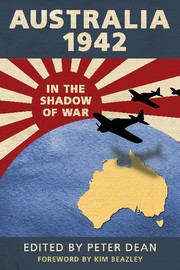Book contents
- Frontmatter
- Foreword
- Contents
- Photos
- Maps
- Charts
- Acknowledgements
- Contributors
- Abbreviations
- Maps
- Introduction
- Part 1 Australia in 1942
- Part 2 Relations, politics and the home front
- Part 3 Australia under threat
- Chapter 6 The Japanese Army’s ‘unplanned’ South Pacific campaign
- Chapter 7 Japanese strategy and intentions towards Australia
- Chapter 8 The air raids on Darwin, 19 February 1942
- Part 4 The war on Australia’s doorstep
- Index
- References
Chapter 8 - The air raids on Darwin, 19 February 1942
Image and reality
from Part 3 - Australia under threat
Published online by Cambridge University Press: 05 January 2013
- Frontmatter
- Foreword
- Contents
- Photos
- Maps
- Charts
- Acknowledgements
- Contributors
- Abbreviations
- Maps
- Introduction
- Part 1 Australia in 1942
- Part 2 Relations, politics and the home front
- Part 3 Australia under threat
- Chapter 6 The Japanese Army’s ‘unplanned’ South Pacific campaign
- Chapter 7 Japanese strategy and intentions towards Australia
- Chapter 8 The air raids on Darwin, 19 February 1942
- Part 4 The war on Australia’s doorstep
- Index
- References
Summary
In the early morning of 19 February 1942 the Japanese Navy’s 1st and 2nd Carrier Divisions, under command of Vice Admiral Nagumo Chuicki – with the four aircraft carriers Akagi, Kaga, Soryu and Hiryu – deployed its attack force for the first raid. The carriers reached their launching point some 350 kilometres northeast of Darwin and sent off 188 aircraft – 36 fighters, 71 dive bombers and 81 level-bombers. At 9.57 a.m. the first of them struck the wharf, the shipping and the town. Of the 55 vessels of all sizes in the harbour on that morning, eight were sunk or run ashore, including the US Navy destroyer Peary, the transports Meigs, Mauna Loa and Portmar, the tanker British Motorist, the coastal traders Zealandia and Barossa – and the liner Neptuna, filled with munitions that were still burning and exploding at the wharf half an hour after the raiders had gone. Apart from the loss of 88 sailors in USS Peary, the greatest loss of life that day occurred on the wharf, where a whole span collapsed, and aboard Neptuna. The town was heavily strafed, although a police count showed that only 17 bombs fell there and property damage was moderate. But the shock to Darwin residents was great, especially as the single bomb that destroyed the Post Office killed nine of the staff, including six women.
By 10.40 a.m. the raiders had departed. Eighty minutes later, 54 land-based Japanese bombers from Kendari and Ambon pattern-bombed the RAAF base, destroying nearly all the aircraft on the ground there, burning out the two hangars, the main store and severely damaging several other buildings. To complete the destruction of that day, out at sea the Japanese air armada sighted the Filipino blockade runner Don Isidro, reporting her presence to Vice Admiral Nagumo, who sent out a flight of aircraft to destroy the ship. This they did, driving her ashore as a burned-out wreck on Bathurst Island and, for good measure, the final act was the sinking of a second blockade runner, the Florence D.
- Type
- Chapter
- Information
- Australia 1942In the Shadow of War, pp. 140 - 156Publisher: Cambridge University PressPrint publication year: 2012



